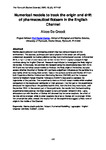Numerical models to track the origin and drift of pharmaceutical flotsam in the English Channel
| dc.contributor.author | De Groodt, A. | |
| dc.date.accessioned | 2022-12-23T19:50:42Z | |
| dc.date.available | 2022-12-23T19:50:42Z | |
| dc.date.issued | 2022 | |
| dc.identifier.citation |
De Groodt, A. (2021) 'Numerical models to track the origin and drift of pharmaceutical flotsam in the English Channel', The Plymouth Student Scientist, 15(2), pp. 127-162. | en_US |
| dc.identifier.issn | 1754-2383 | |
| dc.identifier.uri | http://hdl.handle.net/10026.1/20119 | |
| dc.description.abstract |
Marine plastic pollution is an increasing problem that has serious impacts on the environment. The sources, pathways and fate of plastics in the ocean are still poorly understood, especially for marine pollution coming from marine-based sources. In November 2018, a high number of pharmaceutical bottles named ‘Otrivin’ started to beach in high numbers along the English Channel. Research was initiated to investigate the likely origin of the bottles. In this study, we continue this research using the observational data from 2018-2019 and two numerical ocean models to hindcast the likely origin of the bottles, but also assess whether the effect of Stokes drift can have a significant influence on the particles in a sea mainly driven by strong tidal current. Data of the surface currents and Stokes drift from both Copernicus Marine Environment Monitoring Service (CMEMS) and the European Centre for Medium-Range Weather Forecasts (ECMWF) was used to calculate the trajectories of the particles. Two experiments were run in both ocean models which enabled comparison of the results and verification of their accuracy. The first part of the experiments simulated the trajectories of the particles back in time, from the time they were found, until September 2018. In the second part of the experiments, the results from the backtracking experiments were used as the initial location to run a simulation forward in time. Lastly, simulations run with the effect of Stokes drift showed that for some locations, the effect of the tide will be stronger, while in other locations the effect of Stokes drift is stronger. While few uncertainties arise, overall, the results from all the experiments suggest a likely zone of origin in the middle of the Channel. | en_US |
| dc.language.iso | en | en_US |
| dc.publisher | University of Plymouth | en_US |
| dc.rights | Attribution 3.0 United States | * |
| dc.rights.uri | http://creativecommons.org/licenses/by/3.0/us/ | * |
| dc.subject | Marine plastic pollution | en_US |
| dc.subject | flotsam | en_US |
| dc.subject | Numerical Modelling | en_US |
| dc.subject | Lagrangian | en_US |
| dc.subject | English Channel | en_US |
| dc.subject | CMEMS | en_US |
| dc.subject | ECMWF | en_US |
| dc.subject | Otrivin | en_US |
| dc.title | Numerical models to track the origin and drift of pharmaceutical flotsam in the English Channel | en_US |
| dc.type | Article | en_US |
| plymouth.issue | 2 | |
| plymouth.volume | 15 |



